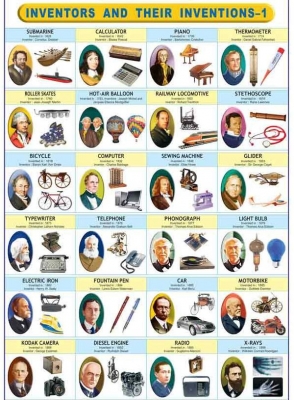
TECHNOLOGY
Technology is the practical use of scientific knowledge to invent tools and make tasks easier. With simple, early technologies, such as the wheel, the invention came first and it was only explained later in scientific terms. Modern technological innovations are usually the result of years of scientific research, financed by commercial organizations.
- Wheel: The first wheels were used in Mesopotamia (now Iraq).They were made from planks nailed together to form a circle.
- Writing: In Mesopotamia, records of accounts and lists of goods were scratched on clay tablets, and people used seals with raised images to mark personal property.
- Paper: The process of paper-making was also invented in China. Rags and plant fibres were mixed with water, beaten to a pulp, then spread out to dry into a sheet.
- Gunpowder: The explosive properties of gunpowder were first used by the Chinese to produce fireworks and dramatic bangs to frighten enemies rather than kill them.
- Spectacles: In the 11th century, the Chinese found that curved pieces of glass (tenses) could bend light. Spectacles were not produced until almost 300 years later.
- Printing: The printing press developed by Johannes Gutenberg used a system of movable type – individual metal letters made quickly and cheaply – allowing books to be mass-produced for the first time.
- Telescope: The first telescope was a refracting telescope that used two lenses to focus light from distant objects.
- Steam engine: James Watt’s rotary steam engine provided the power for the factories and mines of the Industrial Revolution by converting the energy in steam into motion.
- Railway locomotive: The first railway locomotive used a high-pressure steam engine to move a train along rails.
- Electric generator: Michael Faraday invented the first electric motor, which used electricity to produce motion. He then reversed this process, using motion to produce electricity, thus inventing the electric generator.
- Photography: The first practical photographic process was invented by Louis Daguerre. Known as the Daguerreotype, it used a copper plate coated with silver and light-sensitive chemicals to capture the image.
- Telephone: Alexander Graham Bell invented the telephone after discovering that voice vibrations could be converted to electrical signals, sent along a wire, and converted back into sound vibrations at the other end.
- Light bulb: Joseph Swan and Thomas Edison simultaneously came up with the light bulb, which works by causing a metal filament to glow when an electric current passes through it.
- Petrol-engine motor car: The first motor car with an internal combustion engine powered by petrol had a U-shaped steel frame and three wheels.
- Cinema: Brothers Louis and Auguste Lumiere invented a combined camera and projector they called the cinematographe, which projected moving images onto a screen.
- Aeroplane: Wilbur and Orville Wright built the first successful heavier-than-air, powered aircraft. Their first flight lasted only 12 seconds.
- Triode valve: First designed to control electric current, the triode valve went on to be used as an amplifier for radio and TV signals, and as “switches” in computers.
- Radio broadcast: The first public radio broadcasts were heard in 1906. By the mid 1920s, people were buying radio sets for their homes.
- Television transmission: John Logie Baird produced the first television transmission using a series of spinning discs to produce the image. This mechanical device was soon overtaken by the electronic cathode ray tube.
- Transistor: The transistor did the same job as a triode valve, but it was smaller, more reliable, and used less power, paving the way for more compact electronic devices.
- Microchip: This invention integrated thousands of transistors into single miniature chips of silicon, replacing mechanical control devices in household goods and bulky circuits in computers.
- Communications satellite: The launch of the first communications satellite, Telstar, allowed live television programmers and telephone calls to be transmitted around the world by bouncing signals off the orbiting space satellite to receiver dishes on the ground.
- Personal computer: The first successful desktop computer, Apple II, had an integrated keyboard, which connected to a television.
- Mobile phone: Calls are transmitted via a network of short-range local transmitters using radio waves instead of cables.
- Compact disc: The CD uses a laser to read sound information recorded as a series of pits under the disc’s smooth surface.
- IPhone: As technology advances, electronic devices become smaller and more intricate. Gadgets, such as Apple’s iPhone, are designed to perform many different functions, including playing music and videos, storing photos, and accessing the Internet.
- 3-D printer: Unlike ordinary printers, these printers can create three-dimensional (3-D) objects, which have width and height, as well as length, or depth. Regular printers use ink, but 3-D printers mostly use layers of melted plastic to create a model. Metal, chocolate, or even concrete can be used as material to create models.
Picture Credit : Google




